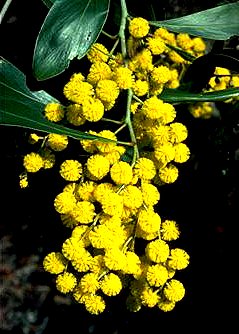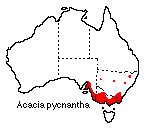 |
The specimen from which it was named
was collected in 1836 in the interior of New South Wales by the Surveyor-General
of New South Wales, Thomas Mitchell, who led two exploratory expeditions
to the Darling and Murray River systems. The British botanist, George Bentham
(1800-1884) described the species in 1842. Bentham wrote Flora Australiensis,
the standard reference text on Australian plants until the publication
of the Flora of Australia, which commenced in 1981.
The generic name Acacia is derived from the Greek 'akis', a point, referring to the prickly leaves of some species. The specific name pycnantha from the Greek 'pyknos', meaning 'dense', and 'anthos', meaning 'a flower', refers to the dense clusters of flowers. There are more than 900 species of Acacia in Australia, making it the largest genus in the Australian flora. The vernacular name, wattle, used for Australian species of Acacia, derives from Anglo-Saxon times. Wattles were long flexible twigs interwoven for the framework on which mud was daubed. This rural British building technique was introduced by early settlers, and an abundant local tree, Callicoma serratifolia (family Cunoniaceae), commonly and perhaps confusingly known as 'black wattle' was first used this way at Port Jackson. Species of Acacia were later used as wattles in Australia. |
 Acacia
pycnantha, Golden Wattle, is a shrub or small tree about 4 to 8 metres
tall. After the seedling stage, true leaves are absent, their function
being performed by phyllodes which are modified flattened leaf stalks lacking
leaf blades. The leathery phyllodes are 6 to 20 cm long, broadly lance
or sickle-shaped and bright green in colour. In spring large fluffy golden-yellow
flower-heads with up to eighty minute sweetly scented flowers provide a
vivid contrast with the foliage. The dark brown mature fruit, 7 to 12 cm
long, splits along one side to release the seeds.
Acacia
pycnantha, Golden Wattle, is a shrub or small tree about 4 to 8 metres
tall. After the seedling stage, true leaves are absent, their function
being performed by phyllodes which are modified flattened leaf stalks lacking
leaf blades. The leathery phyllodes are 6 to 20 cm long, broadly lance
or sickle-shaped and bright green in colour. In spring large fluffy golden-yellow
flower-heads with up to eighty minute sweetly scented flowers provide a
vivid contrast with the foliage. The dark brown mature fruit, 7 to 12 cm
long, splits along one side to release the seeds.